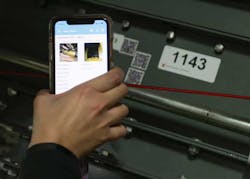Monitoring, recording, analyzing and reporting the performance of equipment in manufacturing and production facilities or distribution centers (DCs) lets companies improve operations and reduce costs. Connecting and tracking equipment with advanced sensors and other Internet of Things (IoT) hardware and software also help maximize the benefits of preventative maintenance programs.
But to enjoy all those benefits, companies need to do some old-fashioned legwork.
So Many Assets, So Little Time
The first step in effectively implementing a proactive maintenance program at a facility, as well as intelligent diagnostic services and predictive approaches, companies to identify every machine and system in a facility. They should also locate and count every spare part, each replacement unit and all the consumables sitting in inventory for maintenance and repairs. Depending on the size and complexity of the plant or DC, there could be tens of thousands of stock keeping units (SKUs).
That’s a big job, one best handled with cloud-based software. This software tracks, reports, communicates and shares performance data for supporting preventative maintenance. It also lets companies better manage the spare parts and components needed to keep production and distribution operations on schedule and within budget, as well as a wide variety of other tasks.
None of that can happen, however, without first completing a thorough asset inventory. And none of the data generated by sensors installed on production and distribution machinery will make much sense if companies haven’t decided how to manage maintenance processes and all those SKUs for repairs and replacements. Few companies or plant managers want to just buy data from a sensor. Ultimately, that data needs to do something to improve operations.
Companies need to make an inventory audit and record appropriate for the scale of their operations. There are ways to mark every asset with a QR code during the audit. Later, technicians can scan QR codes to correctly identify units and minimize errors. This lets them get the right parts at the right time to maintain safe and productive operations. An accurate and accessible inventory, combined with condition monitoring, lets users remotely identify equipment problems, respond if equipment has a problem or act before there is unplanned downtime.
These types of programs also facilitate the standardization and improvement of maintenance, repair and operations (MRO) inventory by minimizing the number of SKUs. This lets companies get replacement equipment faster and installed during scheduled maintenance times, reducing costs and downtime.
Audit Inventory and What’s Essential
The first step, however, is for companies to understand what parts they have and where they are. That’s accomplished by completing an old-fashioned inventory audit. Then companies can categorize and codify the different machinery, parts and pieces, and decide what’s essential to keep in inventory to support operational targets and financial objectives. Questions to ask include:
- Which units must be in inventory?
- How can these units be standardized?
- How can the number and variety of units be reduced?
Companies of all sizes can execute this initial step. It doesn’t require sensors connected to individual equipment or networked to an IT infrastructure. Begin with a simple survey of what’s in inventory and tag each item with a QR code. These actions alone can yield significant savings. Technicians will spend less time walking or climbing to find equipment or parts.
Step two is to invest in putting sensors on equipment and adding them into an enterprise resource planning (ERP) system or cloud-based intelligent software for analysis and reporting. Storing information about each SKU in inventory along with “how to service” or “when to replace” instructions make vital information readily available to technicians and help reduce maintenance and repair costs and downtime. If there is no IT infrastructure, sensors can be connected using cellular technologies.
True Value of Data
Creating a just sensor network will not give operations managers or technicians the insights needed to make well-informed business decisions. The sensors by themselves just generate a bunch of data. That’s why the initial inventory audit to determine how the data will be used is so important.
To realize the most value from investments in sensors and intelligent asset management software, companies must assess the importance or criticality of each piece of equipment, part or SKU in inventory. Knowing the operational aftermath if a part fails and causes unplanned downtime can lead companies to understand how much data really is needed from a sensor. Examples include:
- Will the company continuously stream data 24/7 because an operation is so transient, or are there different operators controlling the equipment and the company wants to see continual changes?
- Can the company pull data samples from a machine four times a day and get more than enough information and insights?
- Or is the equipment generally trouble-free, and the company really only needs to see and understand overall trends and when there are deviations from normal operating ranges?
These questions should be answered in the inventory audit. By doing so, a company can prepare to select sensors and asset software that best match their technologies to the failure modes of its production or DC equipment and the various operating states they go through daily.
Likewise, inventory audits should identify what’s important to know about each piece of equipment. Vibration monitoring sensors can detect micro fractures, but does the company need that for a small-horsepower conveyor motor? It may only need to monitor the motor’s temperature and then alert technicians when it exceeds a certain range. Then they will know it’s time to change out the motor.
IoT technologies can monitor equipment vibration, temperature, belt speed, lubricant and motor current. The resulting real-time or near-real-time data and insights they generate can be used to streamline processes and provide unprecedented access to engineering and design information. They also can help in training, installation, repair and support services, all of which adds up to new capabilities to avoid disruptions to operations and related costs.
Dan Phillips is technical director of monitoring and diagnostics at Regal Beloit Corp.


